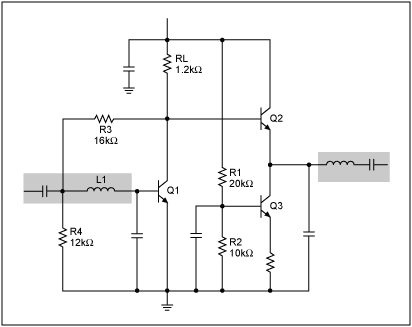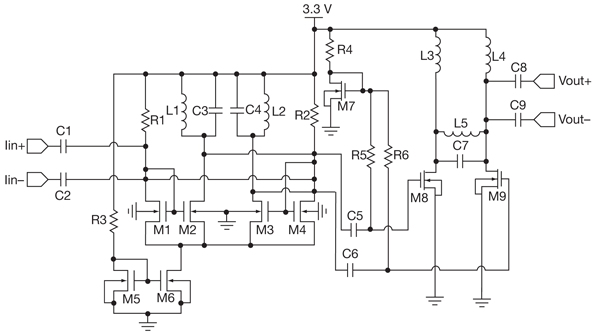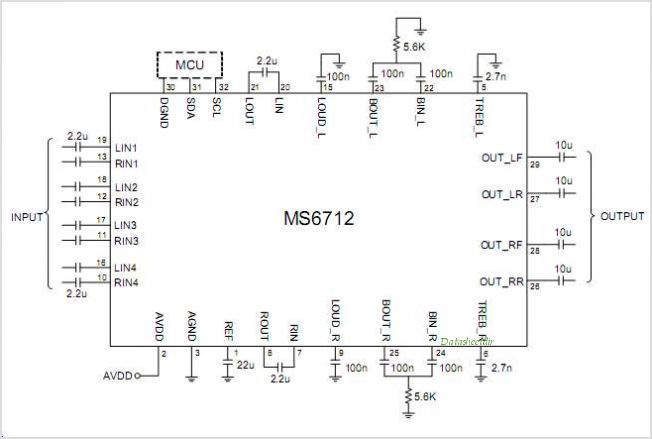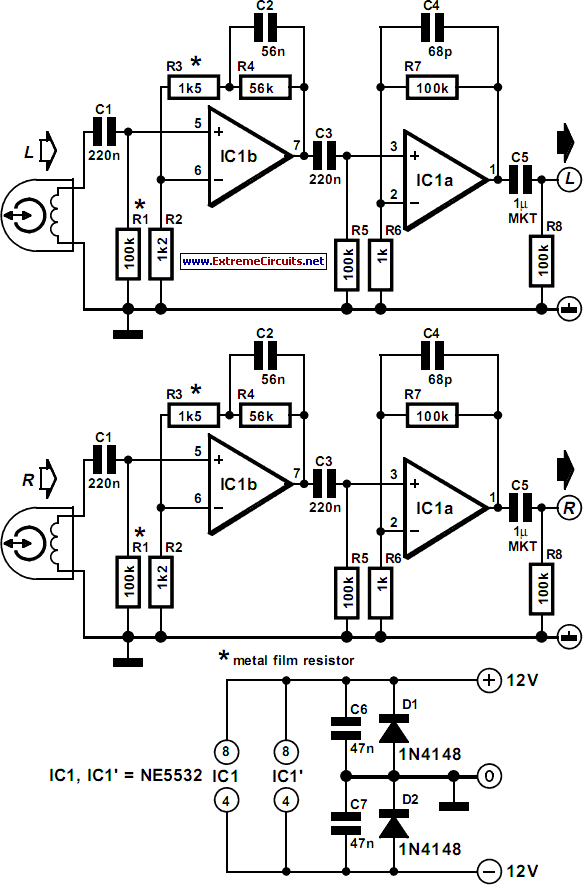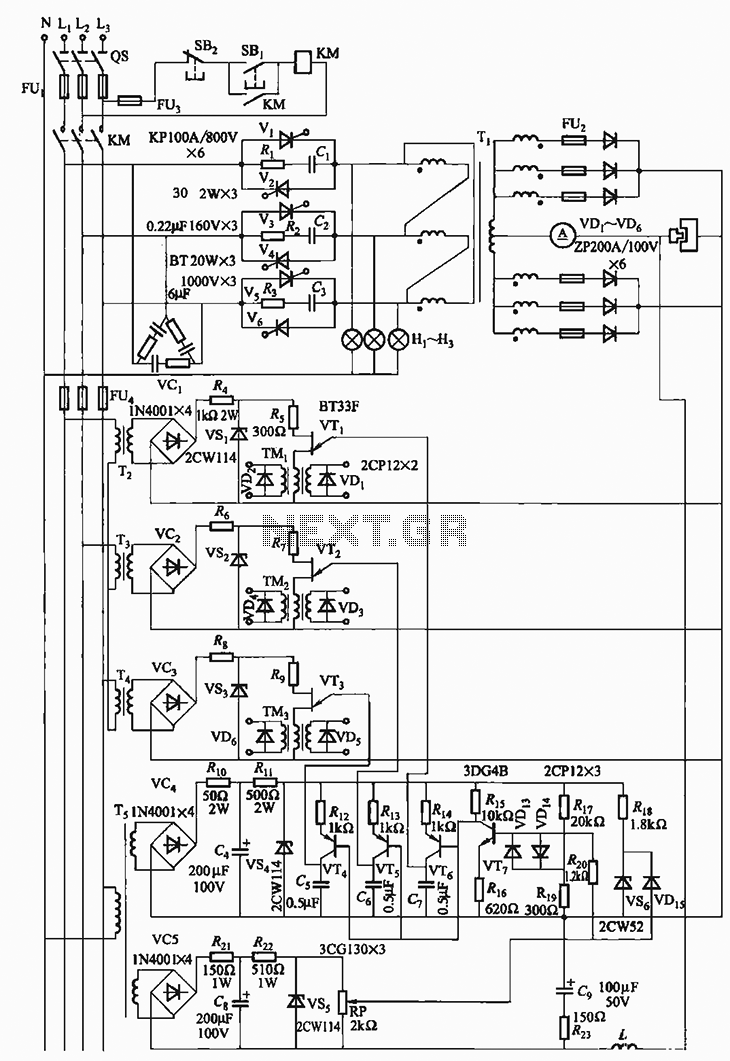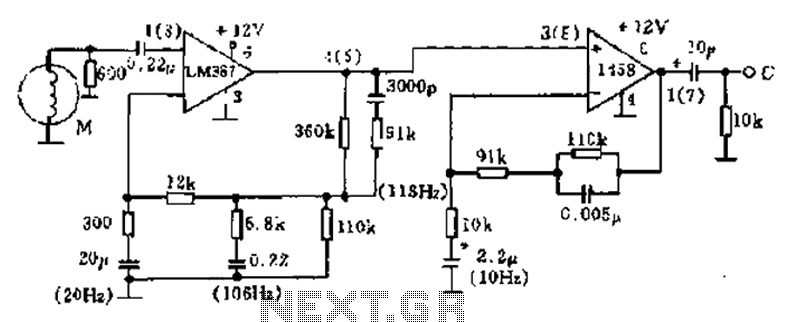
200W Stereo High Power Amplifier LM3886
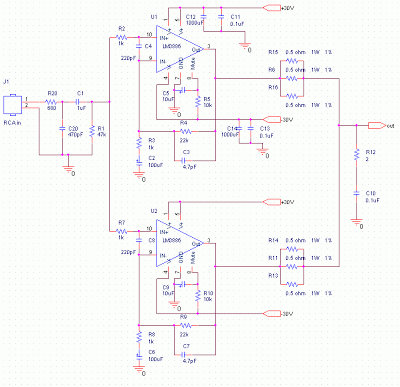
This audio amplifier design employs two LM3886 chips per channel in a parallel configuration, based on the PA100 parallel amplifier detailed in National Semiconductor's application note AN1192. It can deliver approximately 50W into an 8-ohm speaker and 100W into a 4-ohm speaker. As a stereo amplifier, it utilizes four LM3886 chips. The LM3886 is configured in a non-inverting manner, with the input impedance determined by a 47kΩ resistor (R1). A resistor-capacitor filter network consisting of a 680Ω resistor and a 470pF capacitor is implemented to filter high-frequency noise at the RCA input. Additionally, 220pF capacitors (C4 and C8) are employed to eliminate high-frequency noise at the input pins of the LM3886. High-quality audio-grade capacitors are used at various points: a 1µF Auricap for DC blocking at the input, 100µF Blackgate capacitors for C2 and C6, and a 1000µF Blackgate capacitor for supply filtering. The PCB layout features a separation between the power ground and signal ground, with the signal ground positioned centrally and surrounded by the power ground, connected by a thin trace near C5. The PCB layout is created using PADS PowerPCB 5.0, noted for its robust capabilities. A regulated power supply is utilized, with 10,000µF capacitors per rail preceding the LT1083 regulator, followed by 100µF capacitors on the regulator board. This regulation significantly reduces power supply ripple voltage; without it, a slight 50/100Hz hum can be detected from the speaker. The high-current MUR860 diode is incorporated to ensure adequate current flow. The LT1083 voltage regulator can provide up to 8A of current. The transformer used is rated at 500VA with dual 25V outputs. After regulation, the output voltage is 30V. DC measurements show a low 7mV DC offset at the speaker terminals, with a voltage difference of less than 1mV between the outputs of the two chips. The audio quality of this amplifier is comparable to that of the LM3875 amplifier, characterized by clarity and detail, free from hum, hiss, or noise. In comparison to the LM3875 Gainclone, this amplifier delivers twice the power to a 4-ohm speaker, enhancing dynamics and bass response significantly.
This audio amplifier circuit is designed for high fidelity and performance, utilizing a robust configuration that maximizes output power while minimizing noise and distortion. The choice of components reflects a commitment to audio quality, with high-grade capacitors selected for their ability to handle audio signals without introducing unwanted artifacts. The parallel configuration of the LM3886 chips not only increases power output but also improves thermal management and reliability, as each chip shares the load.
The input stage, featuring a non-inverting configuration, ensures that the amplifier maintains a high input impedance, which is beneficial for interfacing with various audio sources without loading them down. The filtering network effectively mitigates high-frequency noise that could compromise audio clarity, providing a cleaner signal path.
The power supply design is equally critical; the use of a regulated supply with substantial capacitance before the voltage regulator ensures that the amplifier receives stable and clean power. This is particularly important in high-performance audio applications where power fluctuations can lead to audible hum or distortion. The LT1083 regulator is a reliable choice, capable of delivering high current while maintaining low dropout voltage, further enhancing the overall performance of the amplifier.
The PCB layout is designed with careful consideration of grounding practices, which is essential for minimizing noise and ensuring signal integrity. By separating the power and signal grounds, the design reduces the potential for ground loops, which can introduce hum and noise into the audio output.
Overall, this amplifier circuit exemplifies the principles of high-performance audio design, combining quality components, thoughtful layout, and effective power management to achieve an exceptional listening experience.This audio amplifier designed uses two LM3886 per channel, in parallel circuit, based on the PA100 parallel amplifier detailed in National Semiconductors application note - AN1192. This amplifier can deliver about 50W into a 8-ohm speaker and 100W into a 4-ohm speaker. This is a stereo amplifier and therefore 4 LM3886s are used. The LM3886 circuit is in a non-inverted configuration, so the input impedance is determined by the input resistor R1, i. e. 47k. The 680 ohm and 470pF resistor capacitor filter network is used to filter out the high frequency noise at the RCA input.
The 220pF C4 and C8 capacitors are used to shot out the high frequency noise at the LM3886 input pins. I used high quality audio grade capacitors at several locations: 1uF Auricap at the input for DC blocking, 100uF Blackgate for C2 and C6, and 1000uF Blackgate at the supply filter.
The PCB is designed in a way that the power ground is separated from the signal ground, as you can see from the below layout. The signal ground is located in the middle and surrounded by the power ground. There is a thin trace near C5 connecting them. The PCB layout is done by using PADS PowerPCB 5. 0. I think it is a powerful layout software. The power supply used is a regulated power supply. I used 10000uF per rail before the LT1083 regulator. After the regulator, I have 100uF on the regulator board. The advantage of using regulator is that the power supply ripple voltage is removed. If power regulation is not used, I can hear very little 50/100Hz hum from the speaker. The high current MUR860 diode is used to ensure high current flow. The voltage regulator used is LT1083, it can provide about 8A of current. Transformer used here is a 500VA 2x 25V. The power supply is then regulated by 2 LT1083, after the regulation, the voltage is 30V. I did some DC measurement and the result is quite good, I got 7 mV of DC offset at the speaker terminal.
The voltage difference between the output of the 2 chips is less then 1 mV. The sound of this amplifier is similar to my LM3875 amplifier, which is very clean and detail. It has no hum, no hiss and no noise. Compared to the LM3875 Gainclone, this amp can deliver twice the power to my 4-ohm speaker, and it improves the dynamics and bass punch a lot. 🔗 External reference
This audio amplifier circuit is designed for high fidelity and performance, utilizing a robust configuration that maximizes output power while minimizing noise and distortion. The choice of components reflects a commitment to audio quality, with high-grade capacitors selected for their ability to handle audio signals without introducing unwanted artifacts. The parallel configuration of the LM3886 chips not only increases power output but also improves thermal management and reliability, as each chip shares the load.
The input stage, featuring a non-inverting configuration, ensures that the amplifier maintains a high input impedance, which is beneficial for interfacing with various audio sources without loading them down. The filtering network effectively mitigates high-frequency noise that could compromise audio clarity, providing a cleaner signal path.
The power supply design is equally critical; the use of a regulated supply with substantial capacitance before the voltage regulator ensures that the amplifier receives stable and clean power. This is particularly important in high-performance audio applications where power fluctuations can lead to audible hum or distortion. The LT1083 regulator is a reliable choice, capable of delivering high current while maintaining low dropout voltage, further enhancing the overall performance of the amplifier.
The PCB layout is designed with careful consideration of grounding practices, which is essential for minimizing noise and ensuring signal integrity. By separating the power and signal grounds, the design reduces the potential for ground loops, which can introduce hum and noise into the audio output.
Overall, this amplifier circuit exemplifies the principles of high-performance audio design, combining quality components, thoughtful layout, and effective power management to achieve an exceptional listening experience.This audio amplifier designed uses two LM3886 per channel, in parallel circuit, based on the PA100 parallel amplifier detailed in National Semiconductors application note - AN1192. This amplifier can deliver about 50W into a 8-ohm speaker and 100W into a 4-ohm speaker. This is a stereo amplifier and therefore 4 LM3886s are used. The LM3886 circuit is in a non-inverted configuration, so the input impedance is determined by the input resistor R1, i. e. 47k. The 680 ohm and 470pF resistor capacitor filter network is used to filter out the high frequency noise at the RCA input.
The 220pF C4 and C8 capacitors are used to shot out the high frequency noise at the LM3886 input pins. I used high quality audio grade capacitors at several locations: 1uF Auricap at the input for DC blocking, 100uF Blackgate for C2 and C6, and 1000uF Blackgate at the supply filter.
The PCB is designed in a way that the power ground is separated from the signal ground, as you can see from the below layout. The signal ground is located in the middle and surrounded by the power ground. There is a thin trace near C5 connecting them. The PCB layout is done by using PADS PowerPCB 5. 0. I think it is a powerful layout software. The power supply used is a regulated power supply. I used 10000uF per rail before the LT1083 regulator. After the regulator, I have 100uF on the regulator board. The advantage of using regulator is that the power supply ripple voltage is removed. If power regulation is not used, I can hear very little 50/100Hz hum from the speaker. The high current MUR860 diode is used to ensure high current flow. The voltage regulator used is LT1083, it can provide about 8A of current. Transformer used here is a 500VA 2x 25V. The power supply is then regulated by 2 LT1083, after the regulation, the voltage is 30V. I did some DC measurement and the result is quite good, I got 7 mV of DC offset at the speaker terminal.
The voltage difference between the output of the 2 chips is less then 1 mV. The sound of this amplifier is similar to my LM3875 amplifier, which is very clean and detail. It has no hum, no hiss and no noise. Compared to the LM3875 Gainclone, this amp can deliver twice the power to my 4-ohm speaker, and it improves the dynamics and bass punch a lot. 🔗 External reference
